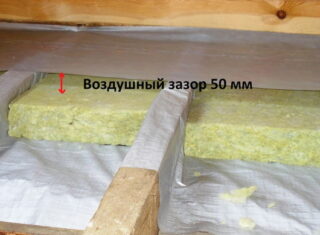The ceiling is a complex structure that allows you to insulate a room, protect it from condensation and remove excess moisture from the room. Vapor barrier is one of the essential elements of the ceiling cake.
The need for vapor barrier for the ceiling in a wooden house
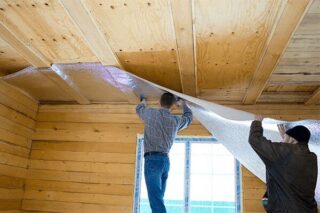
The tree has the ability to regulate the microclimate in the room: it absorbs excess moisture and brings it out, and when the air in the room is too dry, it gives up the moisture accumulated inside. However, in modern houses where sealed plastic windows are installed, very effective heating works, and the walls are additionally insulated, this property turns into a disadvantage.
To effectively heat the room, the heaters are placed as low as possible, because cold air accumulates there. The heated gas rises to the ceiling. The humidity level in warm air is higher. In contact with a cold surface, the air gives off moisture. Part of the tree brings out, but with excess moisture, it simply cannot cope with such a volume. Condensation appears on the surface of the ceiling or, worse, inside the insulation.
The excess is formed due to the high tightness of modern housing. Ordinary old windows let in heat, but at the same time remove moisture. Now this can only be done with additional ventilation.
Vapor barrier functions
A vapor barrier for a ceiling in a wooden house performs the following tasks:
- Prevents the penetration of steam from the air into the structure. At the same time, condensation does not form inside the thermal insulation between the layers of the cake.
- Prevents decay and mold of wooden structures. Even if the attic is not insulated, that is, there is no need for a vapor barrier as such, it is advised to lay it in order to protect the logs or beams.
- Increases the service life of the ceiling structure, as well as the rafter system and roof.
- Provides air removal from the room while maintaining heat and an acceptable level of humidity.
Vapor barrier materials are durable and wear-resistant. They do not require maintenance.
Vapor barrier device
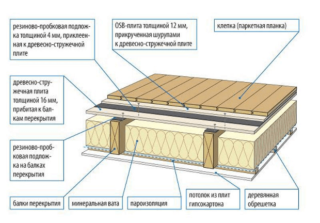
Vapor barrier on the ceiling in a private house is an element of a multi-layer structure of decoration, insulation, waterproofing, base and other things. The cake is arranged like this: each subsequent layer in the direction from the inside out should have a higher level of vapor permeability.
The ceiling structure consists of the following layers:
- Finishing - plasterboard sheets, lining, boards. The nature of the cladding is practically irrelevant.
- Vapor barrier is a layer that prevents steam from passing along with air.
- Insulation.
- Waterproofing - a layer that protects the heat insulator from the action of water from the outside.
- Floor slab if the ceiling is hemmed from below.
In this version, wood - beams, logs, flooring from boards - act as the last layer, and the vapor permeability of the material is the highest in comparison with heat and waterproofing. The vapor permeability of the vapor barrier should be maximized, since this is the first layer in the structure. For private wooden houses, a material with a vapor permeability equal to fractions of a unit is chosen.It is taken into account that this indicator should be noticeably lower than that of a heater.
If thermal insulation is carried out from above, from the attic or 2 floors, the vapor barrier is installed on the ceiling surface from inside the room.
Selection of vapor barrier materials
Vapor barriers are divided according to the principle of operation:
- Standard - do not let steam into the insulation. Installed only from the inside of the structure.
- Reflective membranes are usually foil-clad. Such material not only does not allow steam to pass through, but also retains heat inside. Membranes are more often used in baths and saunas.
- Membranes with controlled permeability - when warm air appears, vapor is escaped through the pores of the membrane. Upon cooling, the process stops. This option is installed in dachas or in houses that are used irregularly.
- Films with variable permeability are a special development for those cases where the vapor barrier can only be installed from above, and there are no ventilation gaps in the ceiling structure. The material also serves as a windbreak.
They choose an option for vapor barrier of the ceiling in a private house, taking into account the design of the ceiling cake, its area, the nature of the upper room - a warm attic, cold, attic.
Glassine and polyethylene
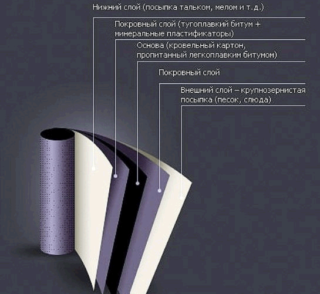
Previously, plastic films were often used for vapor barrier. Of course, this material does not allow steam to pass through at all. But this is what turns into a disadvantage. Moisture settles directly onto the foil or finished ceiling decking, forming condensation.
However, such materials are very resistant to mechanical stress, not sensitive to temperature changes. Therefore, in wooden houses, they are still used in cases where the attic is insulated from the outside using bulk materials - expanded clay, for example.
Glassine - a film with a higher vapor permeability - up to 70 mg / m² per day. Glassine is taken to protect living quarters. If the humidity does not reach a high level - for the bedroom, corridors, living room.
Diffusion membrane films
Cloths of non-woven polypropylene or polyethylene based on a strong two-layer frame. The films are double-sided: the rough side excludes the appearance of condensation, the smooth side prevents the penetration of steam into the heat insulator.
According to the degree of vapor permeability, 3 categories are distinguished:
- Low diffusion membranes - up to 300 g of steam per 1 m² per day. Designed for internal partitions and ceilings under the residential floor.
- Average diffusion - from 300 to 1000 mg / m² per knock. Used in regions with a temperate climate.
- High diffusion - over 1000 mg / m². They are used in areas where the temperature difference inside and outside the building is very large, which contributes to the increased formation of condensation.
Superdiffusion membranes are designed for thick insulation.
Paint vapor barrier
This category includes bitumen mastics, bitumen-kukersolny, as well as PVC and rubber varnishes with a membrane effect. The coating is very thin, but prevents moisture from penetrating inside. In this case, the outflow of steam from the insulation layer is made.
Regular varnish does not perform this function.
Multifunctional isolators
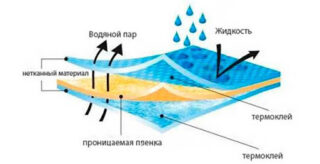
Multilayer polymer diffusion membranes can perform several functions at once. The diffusion membrane with a reflective layer simultaneously protects the ceiling structure from steam and retains heat in the house, and very effectively. Most membrane films play the role of a vapor barrier and wind protection. Reinforced two- and three-layer films do not let water through on one side, and on the other, they trap steam.
Multi-layer vapor barriers are available in rolls and sheets.
Liquid rubber
The material is used for filling flat roofs of small and large areas. Liquid rubber spreads over the surface, forming a layer of uniform thickness, quickly solidifies and turns into a dense, elastic membrane. It adheres very well to the surface and is resistant to mechanical damage.
Liquid rubber is used for finishing ceilings only in non-residential premises.
Required tools and materials
For vapor barrier on the ceiling in a wooden or log house you will need:
- vapor barrier with the required degree of vapor permeability;
- adhesive tape for fastening;
- clamping strips, construction staples and pieces of cardboard.
Of the tools, only scissors are needed to cut the canvas.
Installation features
The recommendations are as follows:
- The strips are laid with an overlap of 10-15 cm. The joints are glued with tape or assembly tape.
- The joints are sealed to the wooden walls, and not just to the beams.
- The film must be free of tension. Better with a little slack.
- The canvas is fixed to the beams with construction brackets and clamping strips. In order not to damage the film, pieces of cardboard are placed under it in the attachment points.
- The foil membrane is fixed with the mirror side inside the attic.
- In places where pipes or a chimney pass, the film is wrapped, wrapped around the pipe and insulated with mounting tape.
Vapor barrier is a necessary element of the ceiling structure. The material is selected according to the level of vapor permeability, taking into account the design of the ceiling, the type of upper room, climatic conditions.

